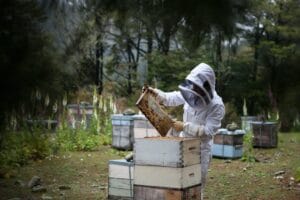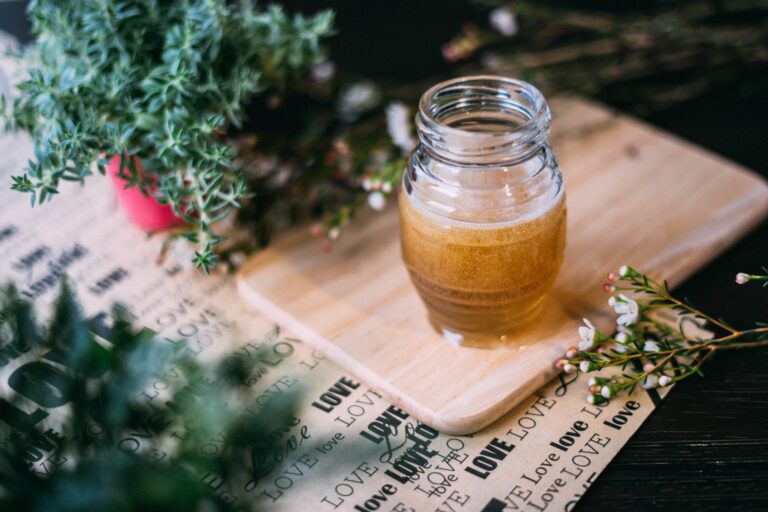Honey is the only food product created by an insect that humans (and horses) eat. But if you think all you can do with honey is sweeten your toast, you are mistaken!
A lot of beneficial things come directly from nature, and one of the most useful for our horses is Mānuka honey, which has a variety of medical uses that are sometimes just as effective as regular medications.
Honey has been known for its medicinal properties for centuries, with its powers mentioned in texts by the Sumerians, Ancient Egyptians, the Ayurvedics of India, Hippocrates, Aristotle, and the Quran.
Our local variety ‘Mānuka’ honey (a rare variety made from the nectar of New Zealand/East Australian Mānuka blossoms) is valued throughout the world for its unique and complex healing properties for humans and horses alike.
The mānuka plant has been long used in traditional Maori medicinal practices – but mānuka honey didn’t become a phenomenon until the 80’s when the NZ biochemist Dr. Peter Molan endorsed its unique antibacterial and healing properties internationally.
Mānuka honey benefits:
- Has proven antibacterial effects against more than sixty organisms, including Escherichia coli.
- Improves the superficial debridement of wounds.
- Enhances tissue growth and the migration of cells.
- Promotes rapid wound healing.
- Can deodorize a wound.
- Treats deep hoof thrush without damaging surrounding tissue.
- Offers anti-inflammatory benefits.
- Is inexpensive and easy to obtain.
- Can provide a calorie rich food source for both horses and humans in an emergency.
Why Honey?
One of the oldest surgical texts in existence is the Edwin Smith papyrus, which dates back to 1600–2200 BC describes the treatment of difficult battle wounds encountered in Ancient Egypt and describes treating a wound using an oil-and-honey–soaked linen bandage.
It is no wonder honey was so popular as a treatment in the ancient world. To treat a wound with honey, all you need to do is cover the wound with honey and apply a bandage on top. The honey works by soaking up any moisture that allows bacteria to thrive and without the bacteria, the wound heals quickly and the sticky consistency is able to protect the wound from dehydration and prevent bacteria from entering.
While there may be more modern substitutes to wound healing, honey has exciting advantages over prescription drugs for wound care. Even better, scientific studies have recently backed up what traditional medicine practitioners already knew, and even better – the holy grail of medicinal honey varieties, is our very own Mānuka honey!

A powerful wound healer
Equine wound care can be a challenging task in Australia and New Zealand.
Especially in regions with warm and moist climates that can cause bacterial and fungal growth, which interferes with wound healing.
The nature of how we typically keep our horses (outside, often in herds) also makes them more susceptible to a long and drawn out healing process that may be challenged further by the need to change dressings regularly, and deal with recurrent bacterial infections.
In a recent study, a group of Israeli researchers followed the healing progress of 89 horses that underwent colic surgery between May 2017 and December 2018 to understand whether treatment with medical grade honey gel on the abdominal incision during surgery could prevent infection. They concluded that the usage of medical grade honey may significantly decrease the prevalence of incisional infections in horses undergoing colic surgery.
Mānuka honey has an acidic pH level that sits between 3.2 and 4.5. When applied to a horse’s wound, this pushes the blood to release oxygen, which is essential for wound healing. The moist and healthy wound environment speeds up healing and thanks to the Mānuka honeys anti-inflammatory and antibacterial qualities, it causes wounds to exude less liquid, and dressings therefore can be changed less frequently (once a day).
The sugar naturally present in honey is able to draw water out of damaged tissues (the osmotic effect) to reduce swelling, encourage blood flow and promote healing. The sugar draws water out of the bacterial cells too, and stops them from multiplying.
Most importantly, Mānuka honey encourages debridement (the shedding of dead tissue) from the wound, a process that kick-starts the horse’s immune response and encourages healthy, new tissue to grow.
In 2017, at the American Association of Equine Practitioners Convention in San Antonio, Texas, Albert Tsang, BVSc, a research student at the University of Sydney presented results of a study Standardbred hind limb injuries treated and reported that the wounds treated with Mānuka honey healed faster than those treated with either generic honey or saline.
Honey is a natural alternative to antibiotics
As well as being cheaper than prescriptive medicines, honey has another upside. It is able to demonstrate antimicrobial powers against the worst bacteria (the variety that don’t have a cell wall and have high levels of antibiotic resistance).
As more and more antibiotics are used, horses are becoming resistant to them. And that is a big problem for us all. Why don’t vets use honey more often? Perhaps because other treatments work better? Or maybe because pharmaceutical companies can’t make as much money off natural remedies? Whatever the reason, with the growing concern in the equine veterinary community about the rise of antibiotic resistance in domestic horses, natural treatments are now gaining traction internationally.
Just like with people, antibiotic resistance is limiting the treatments that can be used by vets, as more and more antibiotics become ineffective.
At the British Equine Veterinary Association Congress in 2019, Dean Hendrickson, a professor at the Clinical Sciences Department at Colorado State University recommended Mānuka honey as a topical wound treatment to combat equine antibiotic resistance.
All types of honey can produce bacteria killing hydrogen peroxide when diluted, but Mānuka honey is unique because it contains extra substances that are able to kill even antibiotic-resistant varieties. Since Mānuka honey’s efficiency is unaffected by bacterial resistance, it is a particularly suitable treatment for immunocompromised horses, or those with difficult-to-treat bacterial infections requiring high concentrations of antibiotics.
Scientific research has proven that Mānuka honey is able to inhibit the growth of more than fifty different types of bacteria (including the dreaded E. coli and salmonella), and since Mānuka honey does not cause antibiotic resistance, it is an excellent alternative to traditional medicines that can drastically improve wound healing time and reduce the duration and dosing of treatments.
What about feeding Mānuka honey to horses?
Juliette de Bairaclai Levy in her book ‘The Complete Herbal Handbook for Farm and Stable’ recommends honey as “a great basic medicine as well as a food, for all living creatures from man to every species of bird. She also writes that Middle Eastern horsemen traditionally feed honey to their horses to give strength and stamina and fertility.
A couple of tablespoons of plain Mānuka honey mixed with feed can give an exhausted horse an instant shot of energy and vitality, and reduce inflammation and discomfort in horses with gastrointestinal or respiratory conditions.
Mānuka honey has been anecdotally reported to lessen symptoms in horses with allergies.
Mānuka honey can be combined with aloe vera juice and given to horses with a syringe as a soothing, restorative tonic for gastric ulcers.
Garlic, like honey has long been recognised and valued for a wide range of properties that can affect circulatory and respiratory systems. Garlic infused honey is far more palatable for horses than just dried garlic, and it is easy to make at home and store too. Mixing just a tablespoon of into a daily feed can support your horses respiratory and digestive system, encourage the healthy expulsion of mucus from the lungs and may benefit healthy hoof formation.
A useful first aid item for hoof and wound care in an emergency.
We can’t always count on having prescription veterinary medicines with us everywhere, so it makes sense to have some alternatives prepared ahead of time.
Mānuka honey is an easy to carry, effective and safe provisional wound and hoof care treatment to use in outdoor environments.
Long lasting and easy to store honey is especially handy in situations where antibiotics are indicated but not available (like high-risk animal bites that would normally require antibiotics within an hour of injury).
Deep Trush Treatment
If your horse is suffering from painful deep thrush in the hoof, you can treat the condition quickly using a mix of ¾ Mānuka honey and ¼ Betadine soaked on a pad and secured in place with kitchen wrap or a bandage for 24 hours (repeated daily over a 2-3 day period).
The sticky honey/iodine mix is able to seep down into the sulci of the frog and help control deep seated, chronic thrush that other treatments struggle to combat. The honey is tough on bacteria but gentle on surrounding skin, and since it is a natural product, it is able to moisturize the treatment area as it heals.
We’d love to hear about your experiences – have you used Mānuka honey on your horse?
References
Dudan, F.E. (1985), The Complete Herbal Handbook for Farm and Stable by Juliette de Bairacli Levy. Published by Faber & Faber, London. Equine Veterinary Journal, 17: 29-29. https://doi.org/10.1111/j.2042-3306.1985.tb02033.x
Combarros-Fuertes P, Fresno JM, Estevinho MM, Sousa-Pimenta M, Tornadijo ME, Estevinho LM. Honey: Another Alternative in the Fight against Antibiotic-Resistant Bacteria?. Antibiotics (Basel). 2020;9(11):774. Published 2020 Nov 4. doi:10.3390/antibiotics911077



